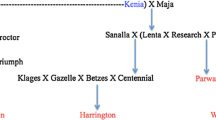Abstract
Seedlings of 62 Australian barley cultivars and two exotic barley genotypes were assessed for resistance to a variant of Puccinia striiformis, referred to as “Barley Grass Stripe Rust” (BGYR), first detected in Australia in 1998, which is capable of infecting wild Hordeum species and some genotypes of cultivated barley. Fifty-three out of 62 cultivated barley cultivars tested were resistant to the pathogen. Genetic analyses of seedling resistance to BGYR in six Australian barley cultivars and one Algerian barley landrace indicated that they carried either one or two major resistance genes to the pathogen. A single recessive seedling resistance gene, rpsSa3771, identified in Sahara 3771, was located on the long arm of chromosome 1 (7 H), flanked by the restriction fragment length polymorphism (RFLP) markers Xwg420 and Xcdo347 at genetic distances of 12.8 and 21.9 cM, respectively. Mapping resistance to BGYR at adult plant growth stages using the doubled haploid (DH) population Clipper × Sahara 3771 identified two major quantitative trait loci (QTL), one on the long arm of chromosome 3 (3 H) and the second on the long arm of chromosome 1 (7 H), accounting for 26 % and 18 % of the total phenotypic variation, respectively. The QTL located on chromosome 7HL corresponded to seedling resistance gene rpsSa3771 and the second QTL was concluded to correspond to a single APR gene, designated rpsCl, contributed by cultivar Clipper.


Similar content being viewed by others
References
Brown WM, Hill JP, Velasco VR (2001) Barley yellow rust in North America. Ann Rev Phytopathol 39:367–384
Chen XM, Line RF (1999) Recessive genes for resistance to Puccinia striiformis f. sp. hordei in barley. Phytopathology 89:226–232
Chen XM, Line RF, Leung H (1993) Relationship between virulence variation and DNA polymorphism in Puccinia striiformis. Phytopathology 83:1489–1497
Karakousis A, Barr AR, Kretschmer JM, Manning S, Logue SJ, Roumeliotis S, Collins HM, Chalmers KJ, Li CD, Lance RCM, Langridge P (2003a) Mapping and QTL analysis of the barley population Galleon × Haruna Nijo. Aust J Agric Res 54:1131–1135
Karakousis A, Gustafson JP, Chalmers KJ, Barr AR, Langridge P (2003b) A consensus map of barley integrating SSR, RFLP, and AFLP markers. Aust J Agric Res 54:1173–1185
Keiper FJ, Hayden MJ, Park RF, Wellings CR (2003) Molecular genetic variability of Australian isolates of five cereal rust pathogens. Mycol Res 107:545–556
Lander ES, Botstein D (1989) Mapping Mendelian factors underlying quantitative traits using RFLP linkage maps. Genetics 121:185–199
Line RF (2002) Stripe rust of wheat and barley in North America: a retrospective historical review. Annu Rev Phytopathol 40:75–118
Manly KF, Cudmore RH Jr, Meer JM (2001) Map manager QTX, cross-platform software for genetic mapping. Mamm Genome 12:930–932
McIntosh RA, Wellings CR, Park RF (1995) Wheat rusts. An atlas of resistance genes. CSIRO Publishing, Melbourne, 200 pp
Park RF, Karakousis A (2002) Characterization and mapping of gene Rph19 conferring resistance to Puccinia hordei in the cultivar ‘Reka 1’ and several Australian barleys. Plant Breed 121:232–236
Stubbs RW (1985) Stripe rust. In: Roelfs AP, Bushnell WR (eds) The cereal rusts. Vol 2, disease distribution, epidemiology and control. Academic Press, Orlando, pp 61–101
Thomas WTB, Powell W, Waugh R, Chalmers KJ, Barua UM, Jack P, Lea V, Forster BP, Swanston JS, Ellis RP, Hanson PR, Lance RCM (1995) Detection of quantitative trait loci for agronomic, yield, grain and disease characters in spring barley (Hordeum vulgare L.). Theor Appl Genet 91:1037–1047
Toojinda T, Broers LH, Chen XM, Hayes PM, Kleinhofs A, Korte J, Kudrna D, Leung H, Line RF, Powell W, Ramsay L, Vivar H, Waugh R (2000) Mapping quantitative and qualitative disease resistance genes in a doubled haploid population of barley (Hordeum vulgare). Theor Appl Genet 101:580–589
Wellings CR (2007) Puccinia striiformis in Australia: a review of the incursion, evolution, and adaptation of stripe rust in the period 1979–2006. Aust J Agric Res 58:567–575
Wellings CR, Burdon JJ, McIntosh RA, Wallwork H, Raman H, Murray GM (2000a) A new variant of Puccinia striiformis causing stripe rust on barley and wild Hordeum species in Australia. Plant Pathol 49:803
Wellings CR, Read B, Moody D (2000b) Stripe rust affecting barley in Australia—current and potential threats. In: Proceedings of the 8th International Barley Genetics Symposium, Adelaide, Australia, October 2000, vol III, pp 197–199
Wellings CR, Bariana H, Park RF (2004) Cereal rust report. Season 2003. Revised variety response to stripe rust for Eastern Australian wheats. Available online at: http://www2.agric.usyd.edu.au:8888/pbi/cereal_rust_reports_crrV1_2.htm
Acknowledgments
The senior author would like to sincerely thank the Grains Research and Development Corporation for the provision of a Postgraduate Research Scholarship that enabled these studies to be conducted. The authors would like to thank Mr. K. Kandel for his valuable technical assistance in the course of this study and acknowledge the support provided by the University of Sydney. The provision of map data for the Clipper × Sahara 3771 population by Professor Peter Langridge is gratefully acknowledged.
Author information
Authors and Affiliations
Corresponding author
Additional information
Colin R. Wellings is on secondment from NSW Agriculture, Australia.
Rights and permissions
About this article
Cite this article
Golegaonkar, P.G., Wellings, C.R., Singh, D. et al. Genetic and molecular analyses of resistance to a variant of Puccinia striiformis in barley. J Appl Genetics 54, 1–9 (2013). https://doi.org/10.1007/s13353-012-0118-9
Received:
Revised:
Accepted:
Published:
Issue Date:
DOI: https://doi.org/10.1007/s13353-012-0118-9




